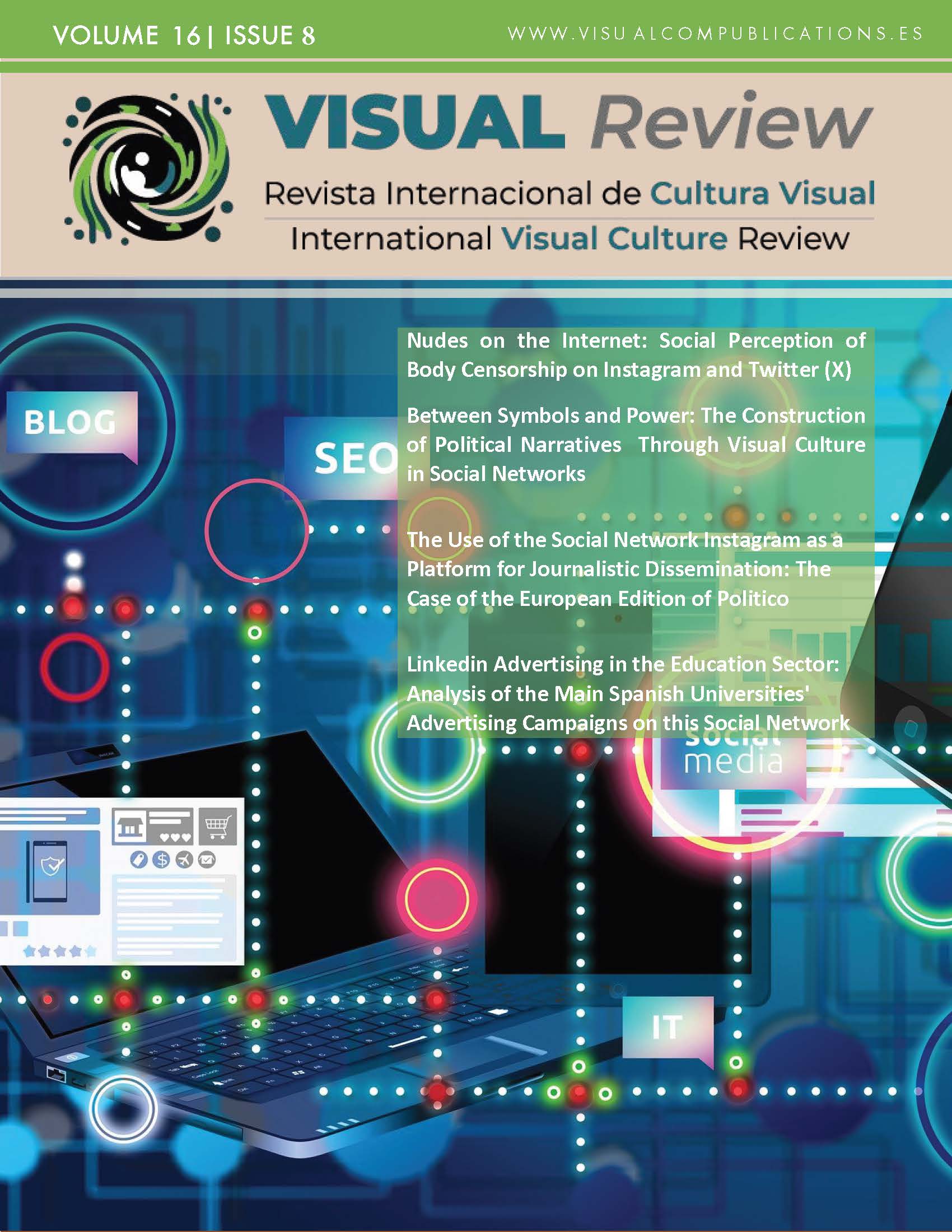Impact of Influencers’ Content on Youth Body Image
Body Positive and Fitspiration movements on Instagram
DOI:
https://doi.org/10.62161/revvisual.v16.5672Keywords:
Influencers, Body Image, Youth, Body Positive, Fitspiration, Instagram, Social mediaAbstract
This research analyzed the impact of Instagram content from Body Positive and Fitspiration influencers on youth body image. It was based on a survey of 377 young people (16-25 years old) and two focus groups (n=10). In addition, a content analysis of 360 influencers’ publications was conducted. According to the results, youth felt that this content had an impact on youth body self-perception, especially Fitspiration. Both types of posts seemed to affect women more, and time on the network did not prove to be determinant. The publications analyzed were mediated by marketing and presented reification traits.
Downloads
Global Statistics ℹ️
|
1675
Views
|
1278
Downloads
|
|
2953
Total
|
|
References
Bard, G. y Magallanes, M. (2021). Instagram: La búsqueda de la felicidad desde la autopromoción de la imagen. Revista Culturales, 9(1), 1-29. https://doi.org/10.22234/recu.20210901.e519 DOI: https://doi.org/10.22234/recu.20210901.e519
Boepple, L.; Ata, R. N.; Rum, R. y Thompson, J. K. (2016). Strong is the new skinny: A content analysis of fitspiration websites. Body Image, 17, 132-135. https://doi.org/10.1016/j.bodyim.2016.03.001 DOI: https://doi.org/10.1016/j.bodyim.2016.03.001
Carrote, E. R.; Prichard, I. y Lim, M. S. (2017). Fitspiration on Social Media: A Content Analysis of Gendered Images. Journal of Medical Internet Research, 19(3). https://doi.org/10.2196/jmir.6368 DOI: https://doi.org/10.2196/jmir.6368
Cohen, R.; Fardouly, J.; Newton-John, T. y Slater, A. (2019a). #BoPo on Instagram: An experimental investigation of the effects of viewing body positive content on young women’s mood and body image. New Media & Society, 21(7), 1546–1564. https://doi.org/10.1177/1461444819826530 DOI: https://doi.org/10.1177/1461444819826530
Cohen, R.; Irwin, L.; Newton-John, T. y Slater, A. (2019b). #Bodypositivity: A content analysis of body positive accounts on Instagram. Body Image, 29, 47-57. https://doi.org/10.1016/j.bodyim.2019.02.007 DOI: https://doi.org/10.1016/j.bodyim.2019.02.007
Cuenca-Piqueras, C.; González-Moreno, M. J. y Checa-Olmos, J. C. (2021). ¿Empoderadas u objetivadas? Análisis de las ciberfeminidades en las influencers de moda. Investigaciones Feministas, 12(1),19-30. https://dx.doi.org/10.5209/infe.68810 DOI: https://doi.org/10.5209/infe.68810
Darwin, H. y Miller, A. (2020). Factions, frames, and postfeminism(s) in the Body Positive Movement. Feminist Media Studies, 21(6), 873–890. https://doi.org/10.1080/14680777.2020.1736118 DOI: https://doi.org/10.1080/14680777.2020.1736118
Denzin, N. K. (1970). Sociological Methods. A Sourcebook. Chicago, IL: Aldine Publishing Company.
Fardouly, J. y Vartanian, L. R. (2015). Negative comparisons about one’s appearance mediate the relationship between Facebook usage and body image concerns. Body Image, 12, 82–88. https://doi.org/10.1016/j.bodyim.2014.10.004 DOI: https://doi.org/10.1016/j.bodyim.2014.10.004
Festinger, L. (1954). A theory of social comparison processes. Human Relations, 7(2), 117–140. https://doi.org/10.1177/001872675400700202 DOI: https://doi.org/10.1177/001872675400700202
Fredrickson, B. L. y Roberts, T. A. (1997). Objectification theory: Toward understanding women’s lived experienced and mental health risks. Psychology of Women Quarterly, 21, 173–206. https://doi.org/10.1111/j.1471-6402.1997.tb00108.x DOI: https://doi.org/10.1111/j.1471-6402.1997.tb00108.x
García Puertas, D. (2020). Influencia del uso de Instagram sobre la conducta alimentaria y trastornos emocionales. Revisión sistemática. Revista Española de Comunicación en Salud, 11(2), 244-254. https://doi.org/10.20318/recs.2020/5223 DOI: https://doi.org/10.20318/recs.2020/5223
Geyser, W. (2022). Nano vs. Micro-Influencer Marketing: What’s the Difference?. Influencer Marketing Hub. https://influencermarketinghub.com/nano-vs-micro-influencer-marketing/
Gill, R. (2007). Postfeminist Media Culture: Elements of a Sensibility. European Journal of Cultural Studies, 10(2), 147–166. https://doi.org/10.1177/1367549407075898 DOI: https://doi.org/10.1177/1367549407075898
Hernández-Sampieri, R.; Fernández-Collado, C. y Baptista-Lucio, M.P. (2010). Metodología de la investigación. McGraw Hill.
IAB. (2022). Estudio de redes sociales 2022. https://iabspain.es/estudio/estudio-de-redes-sociales-2022/
IAB. (2023). Estudio de redes sociales 2023. https://iabspain.es/estudio/estudio-de-redes-sociales-2023/
Instituto Nacional de Estadística [INE] (2022). Población por edad (año a año). https://www.ine.es/jaxi/Tabla.htm?path=/t20/e245/p08/l0/&file=01003.px&L=0
Jenkins, H. (2015). Cultura transmedia: La creación de contenido y valor en una cultura en red. Gedisa.
Lehto, M. y Sklar, M. (2022). “Brand, community, lifestyle”: Fashioning an authentic, body positive influencer brand on Instagram. Fashion, Style & Popular Culture, 9(4), 501-521. https://doi.org/10.1386/fspc_00158_1 DOI: https://doi.org/10.1386/fspc_00158_1
Manjarrés, E. (2021). Del body postivie al body neutrality: miradas alternativas sobre el cuerpo femenino a través de Instagram. En A. Pineda y B. Sánchez-Gutiérrez (Eds.), Comunicación política en el mundo digital: tendencias actuales en propaganda, ideología y sociedad (1076 – 1092). Madrid: Dykinson S. L.
Manning, T. M. y Mulgrew, K. E. (2022). Broad conceptualisations of beauty do not moderate women’s responses to body positive content on Instagram. Body Image, 40, 12-18. https://doi.org/10.1016/j.bodyim.2021.10.009 DOI: https://doi.org/10.1016/j.bodyim.2021.10.009
Marocolo, M.; Meireles, A.; Rodigues de Souza, H.; Ribeiro Mota, G.; Jay Oranchuk, D.; André Arriel, R. y Hora, L. (2021). Is Social Media Spreading Misinformation on Exercise and Health in Brazil? Int. J. Environ. Res. Public Health, 18(22), 11914. https://doi.org/10.3390/ijerph182211914 DOI: https://doi.org/10.3390/ijerph182211914
Ojeda-Martín, A.; López-Morales, Mª P.; Jáuregui-Lobera, I. y Herrero-Martín, G. (2021). Uso de redes sociales y riesgo de padecer TCA en jóvenes. Journal of Negative & No Positive Results, 6(10),1289-1307. https://dx.doi.org/10.19230/jonnpr.4322
Pilgrim, K. y Bohnet-Joschko, S. (2019). Selling health and happiness how influencers communicate on Instagram about dieting and exercise: mixed methods research. BMC Public Health, 19(1054). https://doi.org/10.1186/s12889-019-7387-8 DOI: https://doi.org/10.1186/s12889-019-7387-8
Prichard, I.; Kavanagh, E.; Mulgrew, K.; Lim, M. y Tiggemann, M. (2020). The effect of Instagram #fitspiration images on young women’s mood, body image, and exercise behaviour. Body Image, 33, 1–6. https://doi.org/10.1016/j.bodyim.2020.02.002 DOI: https://doi.org/10.1016/j.bodyim.2020.02.002
Posetti, J.; Aboulez, N.; Bontcheva, K.; Harrison, J. y Waisbord, S. (2020). Violencia en línea contra las mujeres periodistas: Instantánea mundial de la incidencia y las repercusiones. UNESCO e International Center for Journalists (ICFJ). https://unesdoc.unesco.org/ark:/48223/pf0000375136_spa
Quevedo-Redondo, R. y Portalés-Oliva, M. (2017). Imagen y comunicación política en Instagram. Celebrificación de los candidatos a la presidencia del gobierno. El Profesional de la Información, 26(5), 916–927. https://doi.org/10.3145/epi.2017.sep.13 DOI: https://doi.org/10.3145/epi.2017.sep.13
Rodgers, R. F.; Wertheim, E. H.; Paxton, S. J.; Tylka, T. L. y Harriger, J. A. (2022). #Bopo: Enhancing body image through body positive social media-evidence to date and research directions. Body Image, 41, 367–374. https://doi.org/10.1016/j.bodyim.2022.03.008 DOI: https://doi.org/10.1016/j.bodyim.2022.03.008
Schettino, G.; Capasso, M. y Caso, D. (2022). The dark side of #bodypositivity: The relationships between sexualized body-positive selfies on Instagram and acceptance of cosmetic surgery among women. Computers in Human Behavior, 140(107586). https://doi.org/10.1016/j.chb.2022.107586 DOI: https://doi.org/10.1016/j.chb.2022.107586
Streeter, R. (2021). “Bargaining with the status quo”: Reinforcing and expanding femininities in the #bodypositive movement. Fat Studies. An Interdisciplinary Journal of Body Weight and Society, 12, 120–134. https://doi.org/10.1080/21604851.2021.2006958 DOI: https://doi.org/10.1080/21604851.2021.2006958
Tiggemann, M. y Anderberg, I. (2020). Muscles and bare chests on Instagram: The effect of Influencers’ fashion and fitspiration images on men’s body image. Body Image, 35, 237–244. https://doi.org/10.1016/j.bodyim.2020.10.001 DOI: https://doi.org/10.1016/j.bodyim.2020.10.001
Tiggemann, M. y Zaccardo, M. (2015). “Exercise to be fit, not skinny”: The effect of fitspiration imagery on women’s body image. Body Image, 15, 61-67. https://doi.org/10.1016/j.bodyim.2015.06.003 DOI: https://doi.org/10.1016/j.bodyim.2015.06.003
Tiggemann, M. y Zaccardo, M. (2018). “Strong is the skinny”: A content analysis of #fitspiration images on Instagram. Journal of Health Psychology, 23(8). https://doi.org/10.1177/1359105316639436 DOI: https://doi.org/10.1177/1359105316639436
Toffoletti, K. y Thorpe, H. (2020). Bodies, gender, and digital affect in fitspiration media. Feminist Media Studies, 21(5), 822-839. https://doi.org/10.1080/14680777.2020.1713841 DOI: https://doi.org/10.1080/14680777.2020.1713841
Tylka, T. L. (2018). Overview of the field of positive body image. En E. A. Daniels, M. M. Gillen y C. H. Markey (Eds.), Body positive: Understanding and improving body image in science and practice (6–33). New York, NY: Cambridge University Press. https://doi.org/10.1017/9781108297653.002 DOI: https://doi.org/10.1017/9781108297653.002
Pătraș, L. y Todolí, A. (2022). Ser influencer hoy: posibilidades y obstáculos de una nueva fuente de empleo. Universitat de València. https://www.uv.es/ceconomiacol/descarregues/Serinfluencerhoy-informe.pdf
Van Dijck, J. (2016). La cultura de la conectividad: una historia crítica de las redes sociales. Buenos Aires: Siglo XX.
Vendemia, M. A.; de Andrea, D. C. y Brathwaite, K. N. (2021). Objectifying the body positive movement: The effects of sexualizing and digitally modifying body-positive images on Instagram. Body Positive, 38, 137–147. https://doi.org/10.1016/j.bodyim.2021.03.017 DOI: https://doi.org/10.1016/j.bodyim.2021.03.017
Downloads
Published
How to Cite
Issue
Section
License
Copyright (c) 2024 VISUAL REVIEW. International Visual Culture Review / Revista Internacional de Cultura Visual

This work is licensed under a Creative Commons Attribution-NoDerivatives 4.0 International License.
Those authors who publish in this journal accept the following terms:
-
Authors retain copyright.
-
Authors transfer to the journal the right of first publication. The journal also owns the publishing rights.
-
All published contents are governed by an Attribution-NoDerivatives 4.0 International License.
Access the informative version and legal text of the license. By virtue of this, third parties are allowed to use what is published as long as they mention the authorship of the work and the first publication in this journal. If you transform the material, you may not distribute the modified work. -
Authors may make other independent and additional contractual arrangements for non-exclusive distribution of the version of the article published in this journal (e.g., inclusion in an institutional repository or publication in a book) as long as they clearly indicate that the work was first published in this journal.
- Authors are allowed and recommended to publish their work on the Internet (for example on institutional and personal websites), following the publication of, and referencing the journal, as this could lead to constructive exchanges and a more extensive and quick circulation of published works (see The Effect of Open Access).













